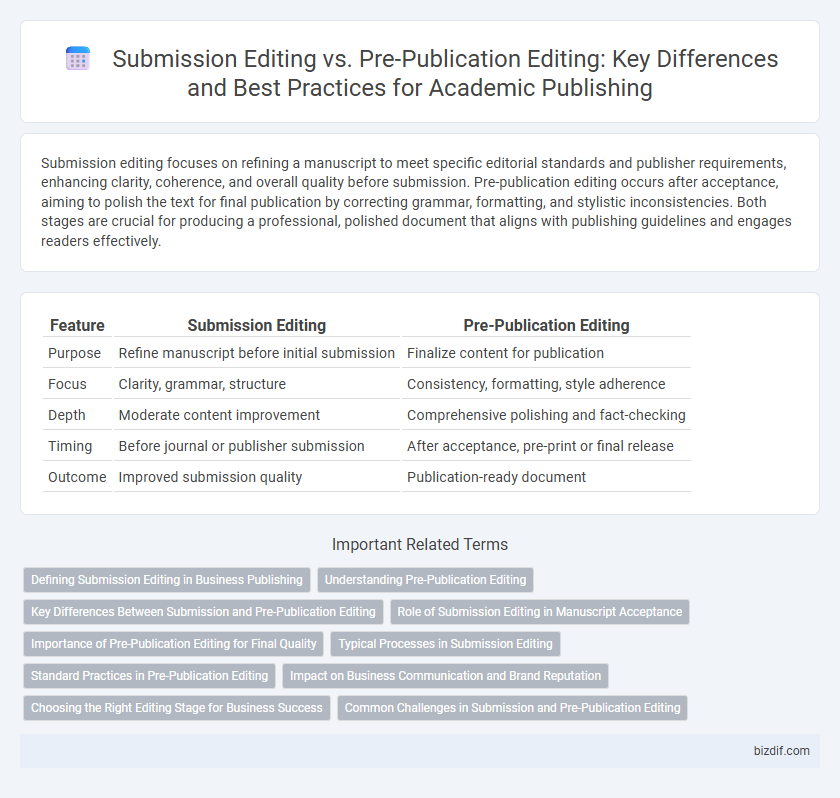Submission editing focuses on refining a manuscript to meet specific editorial standards and publisher requirements, enhancing clarity, coherence, and overall quality before submission. Pre-publication editing occurs after acceptance, aiming to polish the text for final publication by correcting grammar, formatting, and stylistic inconsistencies. Both stages are crucial for producing a professional, polished document that aligns with publishing guidelines and engages readers effectively.
Table of Comparison
| Feature | Submission Editing | Pre-Publication Editing |
|---|---|---|
| Purpose | Refine manuscript before initial submission | Finalize content for publication |
| Focus | Clarity, grammar, structure | Consistency, formatting, style adherence |
| Depth | Moderate content improvement | Comprehensive polishing and fact-checking |
| Timing | Before journal or publisher submission | After acceptance, pre-print or final release |
| Outcome | Improved submission quality | Publication-ready document |
Defining Submission Editing in Business Publishing
Submission editing in business publishing involves reviewing manuscripts to ensure they meet submission guidelines, adhere to style standards, and maintain coherent structure before entering the publication process. This stage focuses on correcting grammar, punctuation, and formatting errors, enhancing clarity, and verifying factual accuracy to elevate the overall quality of the content. Unlike pre-publication editing, submission editing aims to prepare the document for initial acceptance rather than final polish or layout adjustments.
Understanding Pre-Publication Editing
Pre-publication editing involves refining a manuscript to ensure clarity, coherence, and adherence to style guidelines before it reaches the publisher. This stage includes correcting grammar, enhancing readability, and checking formatting to meet publishing standards. Understanding pre-publication editing helps authors produce polished, professional work that is ready for printing or digital release.
Key Differences Between Submission and Pre-Publication Editing
Submission editing focuses on preparing a manuscript to meet the specific guidelines and standards of a target publisher or journal, emphasizing structural coherence, clarity, and adherence to formatting rules. Pre-publication editing, on the other hand, refines the final draft by correcting grammar, punctuation, style inconsistencies, and ensuring the text is polished for public consumption. Key differences include the stage of intervention--submission editing occurs before peer review or acceptance, while pre-publication editing happens after acceptance but before final printing or digital release.
Role of Submission Editing in Manuscript Acceptance
Submission editing plays a critical role in enhancing manuscript clarity, coherence, and adherence to journal guidelines, significantly increasing the likelihood of acceptance. This phase targets structural improvements, grammatical accuracy, and formatting consistency to meet specific publisher requirements. Effective submission editing minimizes reviewer rejections by ensuring the manuscript presents its research clearly and professionally.
Importance of Pre-Publication Editing for Final Quality
Pre-publication editing ensures manuscripts meet rigorous academic standards by thoroughly addressing grammar, clarity, and formatting before submission. This process enhances the overall quality and credibility of the work, reducing the likelihood of rejection by publishers. Careful pre-publication editing ultimately secures a polished, professional presentation that reflects the author's expertise and intent.
Typical Processes in Submission Editing
Submission editing typically involves a thorough review of the manuscript to ensure compliance with journal guidelines, focusing on clarity, coherence, and proper formatting. Editors check for completeness of required documentation, adherence to style files, and the accuracy of references and citations. This process prepares the manuscript for peer review by enhancing readability and addressing language quality without altering the core content.
Standard Practices in Pre-Publication Editing
Standard practices in pre-publication editing prioritize thorough content evaluation, including fact-checking, structural organization, and clarity enhancement to ensure the manuscript meets quality benchmarks before release. Editors implement rigorous language editing for grammar, punctuation, and style consistency aligned with the publication's guidelines. This stage also involves verifying citations and formatting adherence to prevent errors that could impact the work's credibility and reader comprehension.
Impact on Business Communication and Brand Reputation
Submission editing ensures clarity, coherence, and accuracy in documents before they reach external stakeholders, directly enhancing professional business communication. Pre-publication editing refines content for tone, style, and brand alignment, reinforcing a consistent brand reputation across all published materials. Together, these editing stages prevent miscommunication, build trust, and uphold the brand's authority in competitive markets.
Choosing the Right Editing Stage for Business Success
Submission editing focuses on refining manuscripts before sending them to publishers, enhancing clarity, coherence, and adherence to submission guidelines, which can increase acceptance chances. Pre-publication editing involves thorough polishing of content, including fact-checking, style consistency, and error correction, ensuring a professional final product that strengthens brand credibility. Choosing the right editing stage depends on the business's publication timeline and quality expectations to maximize market impact and ROI.
Common Challenges in Submission and Pre-Publication Editing
Submission editing often faces challenges such as inconsistent formatting, incomplete references, and unclear adherence to journal guidelines, which can delay the review process. Pre-publication editing requires precise content polishing, error correction, and style standardization to ensure clarity and consistency, often complicated by tight deadlines and evolving publication standards. Both stages demand meticulous attention to detail and effective communication between authors and editors to minimize revisions and enhance manuscript quality.
Submission Editing vs Pre-Publication Editing Infographic

 bizdif.com
bizdif.com